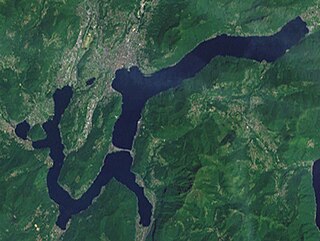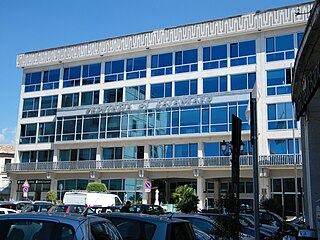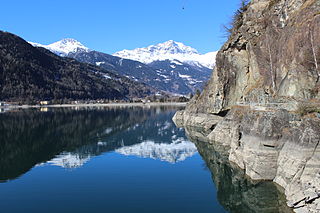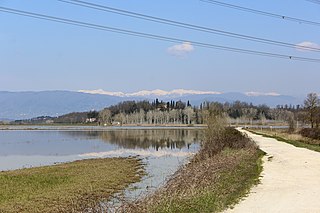
The Sangro is a river in eastern central Italy, known in ancient times as Sagrus from the Greek Sagros or Isagros, Ισαγρος.

Lake Garda is the largest lake in Italy. It is a popular holiday location in northern Italy, about halfway between Brescia and Verona, and between Venice and Milan on the edge of the Dolomites. Glaciers formed this alpine region at the end of the last Ice Age. The lake and its shoreline are divided between the provinces of Verona, Brescia (south-west), and Trento (north). The name Garda, which the lake has been referred to in documents dating to the 8th century, comes from the town of the same name. It is evolved from the Germanic word warda, meaning "place of guard", "place of observation" or "place of safety".

Lake Lugano is a glacial lake which is situated on the border between southern Switzerland and northern Italy. The lake, named after the city of Lugano, is situated between Lake Como and Lago Maggiore. It was cited for the first time by Gregory of Tours in 590 with the name Ceresio, a name which is said to have derived from the Latin word cerasus, meaning cherry, and refers to the abundance of cherry trees which at one time adorned the shores of the lake. The lake appears in documents in 804 under the name Laco Luanasco.

The Province of Brescia is a Province in Lombardy, northern Italy. It has a population of some 1,265,964 and its capital is the city of Brescia.

The province of Catanzaro is a province of the Calabria region of Italy. The city Catanzaro is both capital of the province and capital of the region of Calabria. The province contains a total of 80 municipalities (comuni). Its provincial president is Sergio Abramo.

The Province of Lucca is a province in the Tuscany region of Italy. Its capital is the city of Lucca.

Lake Avernus is a volcanic crater lake located in the Avernus crater in the Campania region of southern Italy, around 4 km (2.5 mi) west of Pozzuoli. It is near the volcanic field known as the Phlegraean Fields and comprises part of the wider Campanian volcanic arc. The lake is roughly circular, measuring 2 km (1.2 mi) in circumference and 60 m (213 ft) deep.

Lake Martignano, is a small lake in Lazio, Italy 24 kilometres (15 mi) north-north-west of Rome, in an extinct crater or maar. Administratively its coast is divided amongst the municipalities of Rome, Anguillara Sabazia and Campagnano di Roma.

Laglio is an Italian comune of 930 inhabitants in the Province of Como in Lombardy. It is on the western shore of the south-western branch of Lake Como, 14 kilometres (9 mi) from the town of Como.

Lago di Poschiavo is a natural lake in the Val di Poschiavo in the Swiss canton of Graubünden. It has an elevation is 962 m (3,156 ft), a length of 2.5 km (1.6 mi), a surface area of 1.98 km2 (0.76 sq mi) and a maximum depth of 85 m (279 ft). The lake is both fed and drained by the Poschiavino river and drains to the south, with its water eventually reaching the Mediterranean via the rivers Adda and Po.

The Toce is a river in Piedmont, Italy, which stretches the length of the Val d'Ossola from the Swiss border to Lake Maggiore into which it debouches near Fondotoce in the commune of Verbania. The river is 83.6 kilometres (51.9 mi) long and is formed in the upper Val Formazza by the confluence of a number of torrents in the plain of Riale.

Lago di Mergozzo is a small sub-alpine lake in northern Italy just to the west of Lago Maggiore and north of Lago d'Orta, at the mouth of the Val d’Ossola in the province of Verbano Cusio Ossola, Piedmont.

Lago Bianco is a reservoir at the Bernina pass in the Swiss canton of Graubünden. It has an elevation is 2,234 m (7,329 ft), a length of 2.85 km (1.77 mi), a surface area of 1.50 km2 (0.58 sq mi) and a maximum depth of 53 m (174 ft). Once the site of two smaller lakes, the current reservoir was formed by the constructions of two dams at its southern and northern ends. The current lake drains to the south, as did both its precursor lakes, with its water eventually reaching the Mediterranean via the rivers Poschiavino, Adda and Po. By contrast, Lej Nair, just below the northern dam. drains north into the Black Sea via the rivers Inn and Danube.

Cecita Lake is a man made lake in the province of Cosenza, Calabria, southern Italy.

Lago di Bientina, also known as Lago di Sesto, was a lake in Tuscany, Italy. Located to the north of the town of Bientina, between Lucca and Pisa, the lake was historically subject to numerous efforts at drainage due to its tendency to flood. Early attempts at canal-building and drainage in the 16th century were hampered by the lake's connection with the Arno River, which often led to backflow and even increased flooding.

The Neto is a river in Calabria, southern Italy. It is the second largest river of Calabria after the Crati.

Botte Donato is a mountain in the Calabria region of southern Italy. It is part of the La Sila mountainous plateau and is the highest peak in the range at 1,928 meters in height. The mountain is within Sila National Park and the province of Cosenza. To the north of the mountain are the lakes Lago di Cecita and Lago di Ariamacina and to the south is the lake Lago Arvo.
The Mucone is a river in the province of Cosenza, Calabria, southern Italy. The source of the river is in La Sila north of Botte Donato. It flows into Lago di Cecita and flows out of the lake near the western border of Sila National Park. The river flows northwest before curving west near Acri. It flows near Bisignano before flowing into the Crati east of Torano Castello. The Mucone is the largest right tributary of the Crati.

Lago Arvo is a lake in the province of Cosenza, Calabria, southern Italy. It is located in La Sila east of Aprigliano and west of San Giovanni in Fiore. The lake is south of Lago di Ariamacina and Botte Donato and northwest of Lago Ampollino. The Arvo flows into and out of the lake. The lake is a reservoir built between 1927 and 1931 by damming the Arvo. Its purpose is to generate hydroelectricity.



















